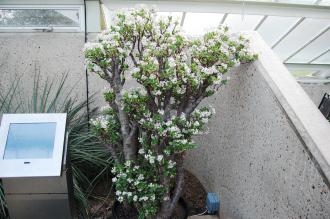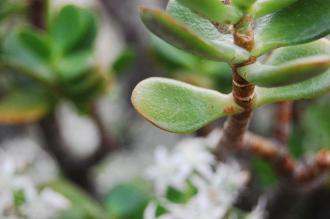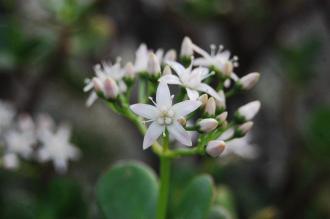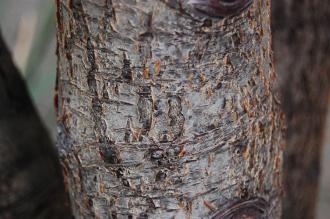
Crassula ovata Mature (10/01/2016, Kew Gardens, London)
Position: Full sun to light shade
Flowering period: Late winter to early spring
Soil: Moist, well drained
Eventual Height: 1m
Eventual Spread: 60cm
Hardiness: 10a, 10b, 11, 12, 13
Family: Crassulaceae

Crassula ovata Leaf (10/01/2016, Kew Gardens, London)
Crassula ovata is an evergreen succulent plant with a bush habit. Its thick mid green shiny leaves are elliptic with entire margins, up to 8cm long and 4cm across. Its branches and trunk will become woody with age and its bark is smooth. Its small pink/ white flowers are star shaped and appear in terminal clusters. Its fruit are small capsules.
Crassula ovata, commonly known as Jade Plant, Friendship Tree, Luck Plant or Money Tree, is native to South Africa and Mozambique. In its native habitat it grows on dry hillsides in thickets with other succulents.

Crassula ovata Flower (10/01/2016, Kew Gardens, London)
The etymological root of the binomial name Crassula is derived from the Latin crassus meaning ‘thick’, in reference to its leaves. Ovata is derived from the Latin ovatus meaning ‘egg shaped’, also in reference to its leaves.
The landscape architect may find Crassula ovata useful as an attractive, undemanding houseplant suitable for bright conditions. Once established this plant is drought tolerant.
Ecologically, Crassula ovata flowers are attractive to pollinating insects.

Crassula ovata Bark (10/01/2016, Kew Gardens, London)
The Royal Horticultural Society have given Crassula ovata their prestigious Award of Garden Merit in 1993.
Crassula ovata prefers moist, fertile, free draining soils. It tolerates most pH of soil. It dislikes wet soils.
When maintaining Crassula ovata as a houseplant it requires little water in the summer months (allowing to dry out between watering) and less during the winter months. Once established feeding should be carried out every three months. Red Spider mite and Mealybugs may both be a pest problem on this plant.

Landscape Architecture

